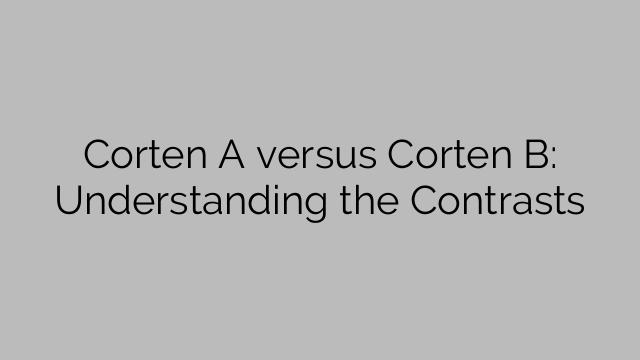Corten steel, also known as weathering steel, has gained significant popularity in the construction industry due to its unique characteristics. It possesses a distinctive rusty appearance that adds a touch of aesthetic appeal to architectural structures. When it comes to using Corten steel, there are two main variations to consider: Corten A and Corten B. Although they have similar properties, there are some key contrasts between the two that are important to understand before deciding which one suits your specific project requirements.
組成と特性:
Corten A and Corten B are both high-strength, low-alloy steels that contain a relatively small percentage of alloying elements such as copper, chromium, nickel, and phosphorus. These elements enhance the steel’s resistance to atmospheric corrosion by forming a protective oxide layer on the surface, which prevents further rusting.
Corten A contains a higher amount of copper than Corten B, making it more resistant to atmospheric corrosion. This results in improved durability, making it suitable for outdoor structures exposed to harsh weather conditions. On the other hand, Corten B has better resistance to localized corrosion and is often used in applications where the steel will be subject to frequent wetting and drying cycles.
To further distinguish between the two, Corten A is often referred to as “patinable” as it develops its rusted appearance more rapidly compared to Corten B. This gives it a more weathered look, with a reddish-brown hue. In contrast, Corten B takes longer to develop its characteristic rusty patina and has a bluish tint.
用途:
Due to their unique properties, both Corten A and Corten B find numerous applications in construction and architectural projects. Their weather-resistant nature allows them to withstand the corrosive effects of different climates, making them highly suitable for outdoor structures such as bridges, façades, sculptures, and even outdoor furniture.
Corten A, with its enhanced resistance to atmospheric corrosion, is often the preferred choice for outdoor structures that require long-term durability. Its faster-developing rusted appearance adds character and charm to architectural designs. Examples include large outdoor sculptures and artistic installations.
Corten B, with its improved resistance to localized corrosion, is often used in applications that involve strong fluctuating environmental conditions. These can include industrial structures, such as storage tanks or chimney stacks, where frequent wetting and drying cycles may occur.
Maintenance and Cost Factors:
When it comes to maintaining Corten A and Corten B, both require minimal upkeep. The rusted surface actually acts as a protective barrier, reducing the need for regular painting or coatings. However, periodic inspections are still recommended to ensure the integrity of the structure and address any localized corrosion issues if they arise.
In terms of the cost, Corten A and Corten B are generally priced similarly, as the main differences lie in their availability and individual project requirements. Both variations are readily available in various thicknesses and sizes, making them relatively easy to source.
結論:
Ultimately, the choice between Corten A and Corten B depends on the specific needs of your project. Consider factors such as environmental conditions, required durability, and desired aesthetic appearance. While Corten A offers greater resistance to atmospheric corrosion and develops a more rapid rustic look, Corten B is better suited for environments with frequent wetting and drying cycles. Regardless of the choice, Corten steel as a whole provides a versatile and attractive option for architects and builders seeking a durable, weathering material that adds character and longevity to their structures.
[ad_2]

